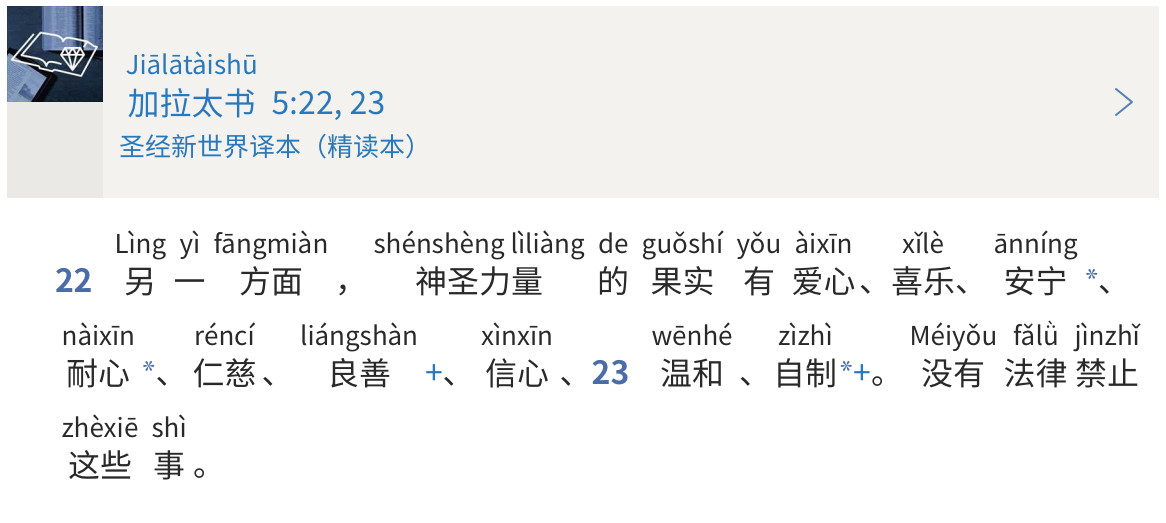réncí (rén·cí {[is] benevolent; kind; humane; compassionate; sensitive} · {[is] compassionate; kind; loving} [→ [[is] kind | kindness]] 仁慈) ← Tap/click to show/hide the “flashcard”
The fifth part of the fruitage of the spirit listed is kindness.— Jiālātàishū (Jiālātài·shū Galatia · Book → [Galatians] 加拉太书 加拉太書) 5:22, 23.

The English word “kindness” is translated into Mandarin in the above scripture as “réncí ({being kind} → [kindness] 仁慈)”, this week’s MEotW.
Note that the Pīnyīn (Pīn·yīn {Piecing Together} · Sounds → [Pinyin] 拼音) Plus information for “réncí ({being kind} → [kindness] 仁慈)” (← tap/click to show/hide the “flashcard”), as used in the above context, shows that in the above context it literally means “being kind”, which in turn effectively means “kindness”. The Pīnyīn (Pīn·yīn {Piecing Together} · Sounds → [Pinyin] 拼音) Plus information renders the literal meaning this way because in this case “réncí ({being kind} → [kindness] 仁慈)” is a stative verb.
Stative Verbs
The ABC Chinese-English Dictionary, edited by John DeFrancis and Victor H. Mair, among others, tells us the following about the entries in it that are marked as stative verbs:
S.V. (Stative Verb, Xíngróngcí 形容词).
These entries are frequently translated into English as adjectives, even though they actually behave in Chinese as verbs. That is, the sense of ‘to be’ is already incorporated into these verbs, e.g. Zhèige hěn hǎo ‘This is quite good.’ In fact, it is simply ungrammatical to place the verb shì, ‘to be’, directly in front of a stative verb.
Because stative verbs are actually verbs, they are directly negated by bù, e.g. bù hǎo ‘not good’, and can be further modified by adverbs of degree such as hěn ‘quite’, fēicháng ‘extremely’ and shífēn ‘very; utterly’. One common function of stative verbs is that they may serve as adverbs to other actions, e.g. mànmàn in mànmàn chī ‘Take your time (eating)’ and rènzhēn in rènzhēn de xiě ‘write carefully’.
Sometimes a Verbal Noun
One might wonder, though, why “réncí ({being kind} → [kindness] 仁慈)” is used in the above scripture to translate “kindness”, a noun, if “réncí ({being kind} → [kindness] 仁慈)” is a stative verb there. This seems to be a case of “réncí ({being kind} → [kindness] 仁慈)” acting as a verbal noun, or gerundial noun. Verbal/gerundial nouns were discussed in the MEotW post on “jiàodǎo (jiào·dǎo teaching · {guiding [→ [instructing]]} 教导 教導)”:
One interesting thing to note about “jiàodǎo (jiào·dǎo teaching · {guiding [→ [instructing]]} 教导 教導)” (and about “jiàoxun (teaching → [reprimanding | knowledge gained from an error] 教训 教訓)”, for that matter) is that their component morphemes seem to basically be verbs. In certain contexts, however, they are used as nouns. An example of this being done in English is that “teach” and “teaching” are verbs (e.g. “Jesus was teaching the crowd.”), but in certain contexts, “teaching” is used as a noun (e.g. “The crowd was amazed at the teaching Jesus shared with them.”). When a word is used this way, it’s called a verbal noun, or a gerundial noun. Verbal nouns are quite common in Mandarin.
Multifaceted
“Réncí (Rén·cí {[is] benevolent; kind; humane; compassionate; sensitive} · {[is] compassionate; kind; loving} [→ [[is] kind | kindness]] 仁慈)”, then, like many Mandarin words, is multifaceted. Sometimes it acts as an adjective, sometimes it’s a stative verb that seems like an adjective, and other times it functions as a noun. Here are examples of it being used in these different ways:
Used as an adjective:
📖 📄 📘 Tā (he 他) shì (is 是) ge ([mw] 个 個/个) hěn (very 很) réncí (kind 仁慈) de (’s 的) rén (person 人).
Used as a stative verb that seems like an adjective:
📖 📄 📘 Tā (he 他) hěn ({very much} 很) réncí ({is kind} 仁慈).
Used as a verbal noun:
📖 📄 📘 Tā (he 他) hěn ({very much} 很) yǒu (has 有) réncí ({being kind} → [kindness] 仁慈).